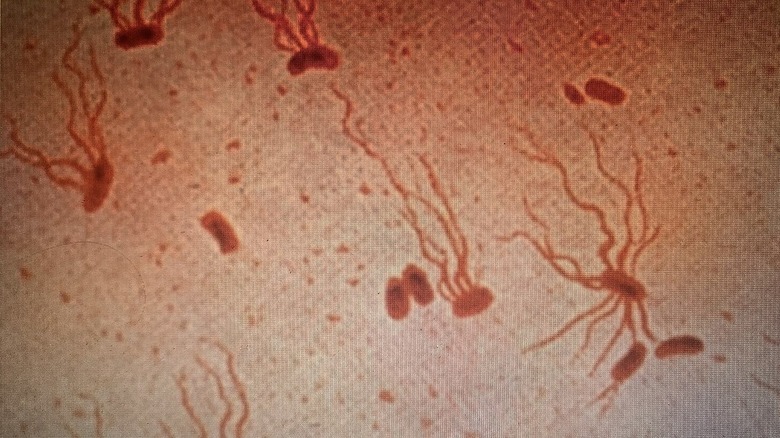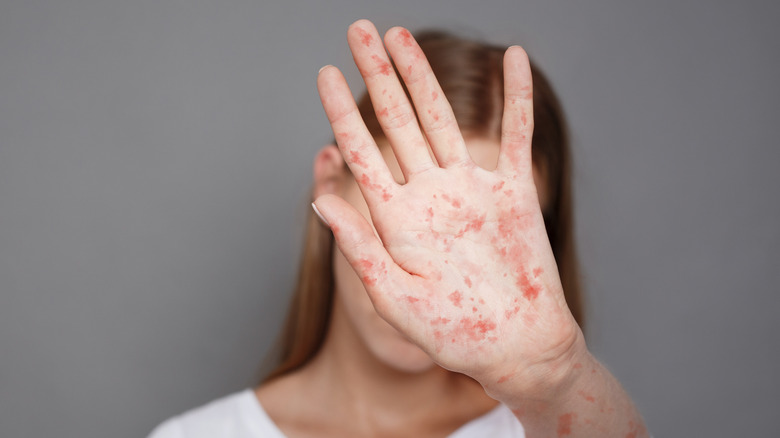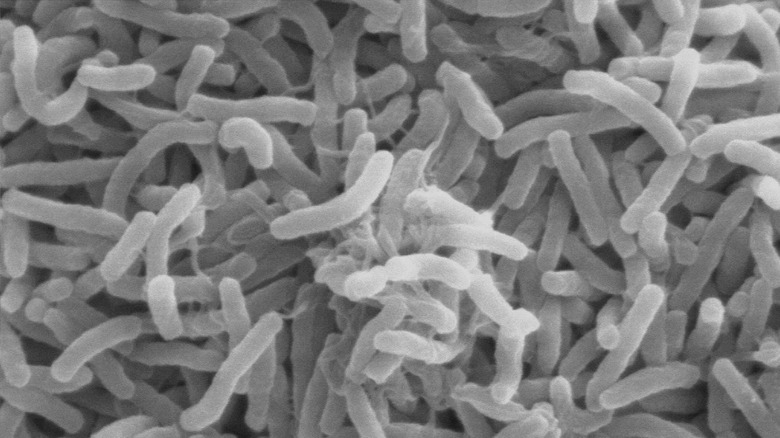What Happened To The Real-Life Diseases That Killed You In Oregon Trail?
The second version of "The Oregon Trail," (released in 1985, per Kotaku), shouldn't be a classic, iconic video game remembered by an entire generation. There are a lot of strikes against it. Strike one: It was educational in nature (the second option on the loading screen was "Learn about the trail," after all, and published by the Minnesota Educational Computing Consortium). Strike two: It wasn't exactly thrilling. And strike three: You died a lot. A lot. So few people actually survived the game that "You Have Died of Dysentery" is an Internet meme 50 years later.
There were plenty of ways to die in "The Oregon Trail," including snakebites, broken limbs, accidental gunshots, and failing to ford fast-moving rivers. This cruelty and frustration was based on solid research. According to the U.S. National Park Service, up to 10% of the folks traveling the real Oregon Trail in the mid-1800s died, which would be about 30,000-35,000 people.
The No. 1 cause of death on the Oregon Trail? Disease. In the game, five specific diseases could strike you or one of your five family members along the way: dysentery, typhoid, measles, cholera, or diphtheria. While this made for a challenging game and a grim reality, surely things have changed since the 19th century when it comes to the diseases so many kids learned about while playing a slow, DOS-based game in their classrooms, right? What happened to the real-life diseases the killed you in "Oregon Trail"?
Dysentery: death by toilet
Dysentery kills you so often in "The Oregon Trail" it's no wonder it's the disease most associated with the game. And once you learn a bit about dysentery, you kind of understand why it's so deadly. According to the encyclopedia Britannica, dysentery is largely spread through contaminated water and food and incubates for a few days before hitting its victims suddenly with fever, inflamed intestines, and a near-constant bloody diarrhea that can quickly lead to death via dehydration.
According to the World Health Organization (WHO), dysentery today is considered one variation of diarrhoeal diseases, which, honestly, we'd kind of prefer the term dysentery. These diseases are collectively the No. 1 cause of death in children globally, killing more than half a million every year — and the WHO notes that the bacterial form afflicts about 165 million people every year, killing around 1.1 million. Surprisingly, according to the National Center for Biotechnology Information, there are still 450,000 cases of bacterial dysentery in the United States annually.
There's no cure, and so far no vaccine to prevent dysentery. What makes this incredibly tragic is that if treated early, the disease is usually survivable, but delays in diagnosis often lead to more severe cases. And it's entirely preventable through safe drinking water, proper hygiene, and basic food preparation precautions, per The National Health Service.
Typhoid fever: not the good kind of fever
Typhoid fever isn't a pleasant way to die. According to the Centers for Disease Control and Prevention (CDC), typhoid is caused by the Salmonella Typhi bacteria, which gets into your body via contaminated water or food. Then it lives in your intestines, and you spread it around by going to the bathroom and not washing your hands. As you might imagine, for folks traveling the Oregon Trail, proper sanitation wasn't easy, and as a result typhoid was pretty common. Typhoid causes a severe fever, weakness, and a loss of appetite, all of which can easily lead to death, especially if you're in the middle of the wilderness a hundred miles from any sort of medical care and a century or so away from modern science.
You might think that a disease that can be prevented by boiling water and washing your hands is probably eradicated in the glorious future! And you would be: wrong. According to 2019 stats from the World Health Organization, around 9 million people get typhoid each year, and about 110,000 people die from it.
The danger depends entirely on where you live. In the United States, there are only about 5,700 estimated cases annually. But you're not entirely safe from an old-timey disease. WZTV reports that there were 71 cases reported in early 2021, prompting an alert from the CDC because nine of the victims had not traveled outside the country, indicating a potential outbreak.
Measles: a nearly forgotten disease
An incredibly contagious viral illness, measles was once one of the most common diseases in the world. According to History, it's so contagious that once exposed (usually when an infected person coughed or sneezed near you, or touched you after touching their nose or mouth), you were more or less guaranteed to get sick. Once you're sick, you'd get a tell-tale rash that would spread all over your body, a dangerously high fever, cough, runny nose, and sore throat. The History of Vaccines notes that most people survive the infection, but it was still incredibly dangerous, with as many as 30% of the infected suffering severe complications that lead to death.
Measles was so common it was accepted as a fact of life — at some point as a kid you were going to get measles, be miserable for a week or two, and then be immune to it for the rest of your life unless it, you know, killed you. Considering all the other hardships on the Oregon Trail, it's little wonder your family died so often from it in the game. In the mid-20th century, the disease still afflicted 48,000 Americans every year and killed around 500.
The good news is that measles is one of the earliest vaccine success stories. The Centers for Disease Control and Prevention reports that in 1963 a vaccine was introduced, and since then there are typically fewer than 1,000 cases each year in the United States.
Cholera: nearly gone
Cholera was a different disease from dysentery, but it killed you the same way: Endless, horrifying diarrhea that resulted in dehydration. A water-borne, bacterial disease, what sets cholera apart is how fast it kills you. According to the World Health Organization, it can result in death in just a few hours. According to the U.S. National Park Service, cholera was one of the primary causes of death to settlers heading west along the Oregon Trail, and the National Oregon/California Trail Center notes that many people would turn up sick at breakfast and be dead by dinner.
Today, cholera is easily treated — if you have access to clean fluids and electrolytes. According to CNN, about 80% of cholera cases can be successfully treated this way, and there are actually several vaccines available to prevent the disease. More importantly, cholera is extremely rare in developed nations. The CDC, for example, reports that in the United States, most cases of cholera are actually contracted in foreign countries, and CNN notes that in 2019 there were zero cases in the U.S.
That's great for us, but the rest of the world isn't so lucky. In 2019 there were 923,037 reported cases of cholera in 55 countries, resulting in 1,911 deaths. But the bottom line is that if you get cholera, and you're not a 19th-century farmer making a brutal journey west in search of a better life, you've got an excellent chance of survival.
Diphtheria: making a comeback
According to the Immunization Action Coalition, diphtheria is a disease caused by airborne bacteria, meaning you breathe it in. You then walk around breathing and coughing the bacteria into other people for a while. After a few days, you'll develop cold-like symptoms, and a fibrous coating begins to grow in the throat, making it hard to breathe. The coating can also grow over the nose and eyes. It kills about 10% of people who contract it. It's unsurprising that it was a major killer on the Oregon Trail, according to the encyclopedia Britannica. And Nature reports that in the later 19th century, it was still had a fatality rate in children of 42% to 49%.
Luckily, there's a reason you've never heard of diphtheria outside the game. As reported by Slate, an effective antitoxin for treating diphtheria was developed in the late 19th and early 20th centuries, and the CDC reports that the modern day vaccination (as part of the standard DTaP vaccine given to most children) has pretty much eradicated the disease in the U.S.
There's some bad news on the horizon, unfortunately. According to Technology Networks, diphtheria is developing antibiotic resistance and cases are on the rise — doubling from 8,105 cases in 2017 to 16,651 cases in 2018. That's stoking fears the disease might stage a "vaccine escape."





